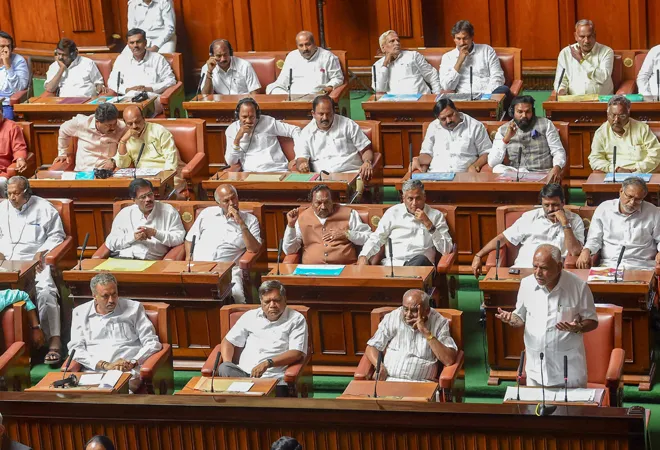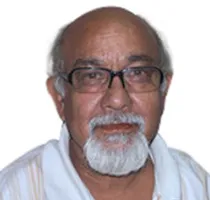
The electoral outcome of the Karnataka assembly election clearly shows that no party got a clear verdict from the electorate, but still every party went to town claiming that people’s mandate is in its favour.
While the Bharatiya Janata Party (BJP) won 104 seats out of 222 for which polling was held on 12 May, the party ended short of a clear majority. It polled 36.2 percent popular votes. In the 2014 general elections, it had polled 43.4 percent votes while in 2013 assembly elections it had only 19.9 percent votes, because the party had faced split with former Chief Minister B.S. Yeddyruppa contesting the election on a separate symbol.
The BJP had emerged as the single largest party in the 2008 assembly elections and had formed the government. Then too, the party had fallen three seats short of a clear majority, but it had managed to muster a majority by weaning away MLAs from other parties.
The BJP increased its seat share in the 224-strong assembly by projecting Yeddyruppa as its chief ministerial candidate. Yeddyruppa, leader of the Lingayats that has about 17% votes, had damaged the BJP’s electoral prospects in the 2013 assembly elections.
The BJP’s attempts to polarise the electorate appear to have paid rich dividends as it won 13 out of the total 16 assembly seats in the coastal region. In the 2013 election, the BJP had won only three seats and the Congress had 16 seats in this region.
The BJP’s attempts to polarise the electorate appear to have paid rich dividends as it won 13 out of the total 16 assembly seats in the coastal region.
Another factor that contributed to the BJP’s kitty was a tacit understanding with the Janata Dal (Secular) — JD(S). The BJP fielded weak candidates in the constituencies which are the stronghold of the JD(S) so that the Congress could be defeated.
The blitzkrieg of rallies and roadshows by BJP leaders, including Prime Minister Narendra Modi and party chief Amit Shah, helped in mobilising the uncommitted voter. Better resources and meticulous election planning by the BJP also contributed to the enhancement of seats and poll percentage.
The Congress, going into election as a ruling party, lost the polls as its tally of seats came down from 122 in 2013 to 78, despite polling 38 percent popular votes. It had polled 36.6 percent votes in the 2013 assembly elections while its poll percentage in the 2014 general elections was 41.2 percent.
The Congress lost mainly because of the anti-incumbency factor that had developed among the electorate over the five years of its rule. The strategy of Chief Minister Siddaramaiah to focus primarily on minorities, Dalits and backwards and paying less attention to two leading castes, namely the Vokaligas and Lingayats, seems to have backfired.
Another factor that appears to have adversely affected the Congress is the neglect of urban centres and focusing on the rural countryside. The Congress also failed to develop an understanding with the JD(S) as it believed that it can take both the BJP and JD(S) on its own strength.
The JD(S) won 37 seats, three less than in 2013. It got 18.3 percent of the popular votes against the 20.2 percent in 2013. Independents and others won three seats.
In short, the Karnataka electorate did not give a clear mandate to any party. But it happens in democracies that follow the first past the post system.
A consequence of no party getting a clear majority was the accompanying problem of a government formation as the BJP — by virtue of being the single largest party — staked its claim to form the government.
At the same time, the Congress and the JD(S) jointly staked the claim to form the government since the combined strength of the MLAs of the two parties crossed the halfway mark comfortably.
A consequence of no party getting a clear majority was the accompanying problem of a government formation as the BJP — by virtue of being the single largest party — staked its claim to form the government.
Karnataka Governor Vajubhai Vala, a former ministerial colleague of the Prime Minister when he was the chief minister in the state of Gujarat, chose to invite the two time chief minister and leader of the BJP legislative party, B.S. Yeddyruppa, to form the government and administered the oath of office on 17 May. The Governor gave 15 days time to Yeddyruppa to prove the majority of his government.
The Congress-JD(S) moved the apex court of the country, challenging the Governor’s decision. On 18 May, the Supreme Court, hearing the Congress-JD(S) petition at nocturnal hours, while upholding the Governor’s right to call the leader of the single largest party to form the government first, directed the Governor to hold the floor test latest by 4:00 p.m. on 19 May.
Yeddyruppa resigned just before the floor test since the BJP did not have numbers on its side. Thus, he joined the company of Jagdambika Pal — a BJP MP from Uttar Pradesh, who until now had the distinction of being shortest serving chief minister of the country.
Notwithstanding the difficulties by the constitutional authorities (by the Karnataka Governor in this case) on the path of the formation of a popularly elected government, the outcome of the assembly elections is going to impact the next general elections in 2019, or whenever held.
The course of events after the declaration of the results of the assembly election on 15 May has dented the image of the BJP, though by tendering the resignation before the trust vote, the ruling party in New Delhi has sought to arrest the damage.
The coming together of the Congress and the JD(S) in Karnataka is a setback to the BJP. The BJP, in a three cornered contest, had won 17 Lok Sabha seats in the 2014 general elections and the Congress had nine seats while the JD(S) had two. In one-to-one fight, it may become very difficult for the BJP to retain as many seats in the coming general election.
On the other hand, the Congress has been able to turn its defeat in the assembly elections into an opportunity for itself. It has earned an ally in Karnataka and has been able to enthuse its cadres and state leadership.
In coming weeks and months, momentum generated in Karnataka is going to boost the morale of the party in the coming elections in Madhya Pradesh, Rajasthan and Chhattisgarh.
The developments in Karnataka are bound to give fillip to efforts for the unity of the opposition to take on the BJP and Prime Minister Narendra Modi in the coming general elections slated for the first quarter of the next year.
The views expressed above belong to the author(s). ORF research and analyses now available on Telegram! Click here to access our curated content — blogs, longforms and interviews.



 The electoral outcome of the Karnataka assembly election clearly shows that no party got a clear verdict from the electorate, but still every party went to town claiming that people’s mandate is in its favour.
While the Bharatiya Janata Party (BJP) won 104 seats out of 222 for which polling was held on 12 May, the party ended short of a clear majority. It polled 36.2 percent popular votes. In the 2014 general elections, it had polled 43.4 percent votes while in 2013 assembly elections it had only 19.9 percent votes, because the party had faced split with former Chief Minister B.S. Yeddyruppa contesting the election on a separate symbol.
The BJP had emerged as the single largest party in the 2008 assembly elections and had formed the government. Then too, the party had fallen three seats short of a clear majority, but it had managed to muster a majority by weaning away MLAs from other parties.
The BJP increased its seat share in the 224-strong assembly by projecting Yeddyruppa as its chief ministerial candidate. Yeddyruppa, leader of the Lingayats that has about 17% votes, had damaged the BJP’s electoral prospects in the 2013 assembly elections.
The BJP’s attempts to polarise the electorate appear to have paid rich dividends as it won 13 out of the total 16 assembly seats in the coastal region. In the 2013 election, the BJP had won only three seats and the Congress had 16 seats in this region.
The electoral outcome of the Karnataka assembly election clearly shows that no party got a clear verdict from the electorate, but still every party went to town claiming that people’s mandate is in its favour.
While the Bharatiya Janata Party (BJP) won 104 seats out of 222 for which polling was held on 12 May, the party ended short of a clear majority. It polled 36.2 percent popular votes. In the 2014 general elections, it had polled 43.4 percent votes while in 2013 assembly elections it had only 19.9 percent votes, because the party had faced split with former Chief Minister B.S. Yeddyruppa contesting the election on a separate symbol.
The BJP had emerged as the single largest party in the 2008 assembly elections and had formed the government. Then too, the party had fallen three seats short of a clear majority, but it had managed to muster a majority by weaning away MLAs from other parties.
The BJP increased its seat share in the 224-strong assembly by projecting Yeddyruppa as its chief ministerial candidate. Yeddyruppa, leader of the Lingayats that has about 17% votes, had damaged the BJP’s electoral prospects in the 2013 assembly elections.
The BJP’s attempts to polarise the electorate appear to have paid rich dividends as it won 13 out of the total 16 assembly seats in the coastal region. In the 2013 election, the BJP had won only three seats and the Congress had 16 seats in this region.
 PREV
PREV


